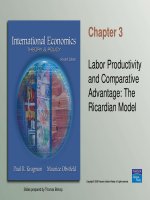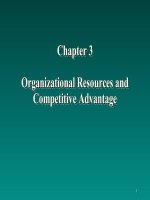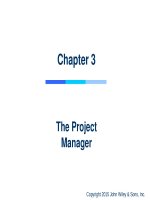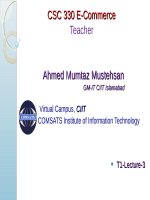Lecture E-Commerce - Chapter 3: The internet and the web (part I)
Bạn đang xem bản rút gọn của tài liệu. Xem và tải ngay bản đầy đủ của tài liệu tại đây (1.37 MB, 44 trang )
CSC 330 E-Commerce
Teacher
Ahmed Mumtaz Mustehsan
GM-IT CIIT Islamabad
•
•
Virtual Campus, CIIT
COMSATS Institute of Information Technology
•
T1-Lecture-3
The Internet and The Web
Chapter-2
Part-I
T1-Lecture-3
For Lecture Material/Slides Thanks to:
Copyright © 2010 Pearson Education, Inc
Objectives
Define
the origin and evolution of the Internet.
Identify the key technology concepts behind the
internet
Describe the role of Internet protocols and utility
programs
Explain the current structure of Internet.
Understand the limitations of todays internet
Describe the potential capabilities of Internet II
Understand how the world wide web works
Describe how internet and web features and services
support e-commerce.
T1-Lecture-3
Ahmed Mumtaz Mustehsan
Copyright © 2010 Pearson Education, Inc
1-3
The Internet: Technology Background
Internet
Interconnected
network of thousands of networks and
millions of computers
Links
businesses, educational institutions, government
agencies, and individuals
World Wide Web (Web)
One
of the Internet’s most popular services
Provides
access to around billions, possibly trillions, of
Web pages
T1-Lecture-3
Ahmed Mumtaz Mustehsan
Copyright © 2010 Pearson Education, Inc
1-4
The Evolution of the Internet 1961 - Present
Innovation
Phase, 1964 -1974
Institutionalization
Commercialization
T1-Lecture-3
Phase, 1975 -1994
Phase,1995 - present
Ahmed Mumtaz Mustehsan
Copyright © 2010 Pearson Education, Inc
1-5
The Evolution of the Internet 1964 - 1974
Innovation Phase: (1964 -1974)
The
basic building blocks were introduced such as;
packet-switching hardware, client/server computing, and a
communications protocol called TCP/IP
The
original purpose of the Internet, was to link large
mainframe computers on different university/college
campuses.
This
kind of one-to-one communication between
campuses was previously possible only through the
telephone system or postal mail.
T1-Lecture-3
Ahmed Mumtaz Mustehsan
Copyright © 2010 Pearson Education, Inc
1-6
The Evolution of the Internet 1975 -1994
Institutionalization Phase: (1975 -1994)
Large
institutions such as the US Department of Defense
(DoD) and the National Science Foundation (NSF)
provided funding to legitimate for the fledging invention
called the Internet.
DoD
contributed $1 million to further develop the network
into a robust military communications system so that it
could withstand during nuclear war.
In
1986, the NSF assumed responsibility for the
development of a civilian Internet (NSFNET) and began a
ten-year-long $200 million expansion program.
T1-Lecture-3
Ahmed Mumtaz Mustehsan
Copyright © 2010 Pearson Education, Inc
1-7
The Evolution of the Internet (1995Present)
Commercialization Phase: (1995 – present)
Government
agencies encouraged private
corporations to take over and expand both the Internet
backbone and local services to ordinary citizens who
were not students.
By
2000, the Internet’s use had expanded well
beyond military installations and research universities
and came into the public domain.
T1-Lecture-3
Ahmed Mumtaz Mustehsan
Copyright © 2010 Pearson Education, Inc
1-8
An instance of internet - active nodes
Source: />T1-Lecture-3
Ahmed Mumtaz Mustehsan
Copyright © 2010 Pearson Education, Inc
1-9
The Internet: Key Technology Concepts
Network as Defined by NSF:
Uses
IP addressing
Supports
TCP/IP
Provides
services to users, in manner similar to
telephone system
Three important concepts:
1. Packet switching
2. TCP/IP communications protocol
3. Client/server computing
T1-Lecture-3
Ahmed Mumtaz Mustehsan
Copyright © 2010 Pearson Education, Inc
110
Packet Switching
Packet Switching:
Slices digital messages into packets
Sends packets along different communication paths as
they become available
Reassembles packets once they arrive at destination
Uses routers
Special
purpose computers that interconnect the
computer networks make up the Internet and route
packets.
Routing algorithms ensure packets take the best
available path toward their destination.
Less expensive, wasteful than circuit-switching.
T1-Lecture-3
Ahmed Mumtaz Mustehsan
Copyright © 2010 Pearson Education, Inc
111
Packet Switching
Packet Switching Demo
/>
T1-Lecture-3
Ahmed Mumtaz Mustehsan
Copyright © 2010 Pearson Education, Inc
112
Key Concept Related to TCP/IP
Protocol
A set of rules and standards for data transfer
Transmission Control Protocol/Internet Protocol
(TCP/IP) the core communications protocol for the
Internet
TCP
Protocol that establishes the connections among
sending and receiving Web computers and handles the
assembly of packets at the point of transmission, and
their reassembly at the receiving end
IP
protocol that provides the Internet’s addressing
scheme and is responsible for the actual delivery of the
packets
T1-Lecture-3
Ahmed Mumtaz Mustehsan
Copyright © 2010 Pearson Education, Inc
113
TCP/IP
Internet Protocol (IP):
Provides the Internet’s addressing scheme.
Transmission Control Protocol (TCP):
Establishes connections between sending and receiving
Web computers
Handles assembly of packets at point of transmission,
and reassembly at receiving end
Four TCP/IP Layers (hourglass model)
1. Network Interface Layer
2. Internet Layer
3. Transport Layer
4. Application Layer
T1-Lecture-3
Ahmed Mumtaz Mustehsan
Copyright © 2010 Pearson Education, Inc
114
The TCP/IP Architecture and Protocol
Suite
T1-Lecture-3
Ahmed Mumtaz Mustehsan
Copyright © 2010 Pearson Education, Inc
115
Key Concept Related to TCP/IP
Network Interface Layer:
Responsible for placing packets on, and receiving
them from, the network medium.
Internet Layer
Responsible for addressing, packaging, and routing
messages on the Internet
Transport Layer
Responsible for providing communication with the
application by acknowledging and sequencing the
packets to and from the application
T1-Lecture-3
Ahmed Mumtaz Mustehsan
Copyright © 2010 Pearson Education, Inc
116
Key Concept Related to TCP/IP
Application Layer
Provides a wide variety of applications (HTTP, FTP,
SMTP ) with the ability to access the services of the
lower layers of TCP/IP.
Internet address
Internet address expressed a unique number that
appears as a series numbers separated with periods,
such as 64.49.254.91 carrying the address of an
individual machine on the internet.
T1-Lecture-3
Ahmed Mumtaz Mustehsan
Copyright © 2010 Pearson Education, Inc
117
Internet (IP) Addresses
How 500 million people will be addressed?
The answer is IP addressing version 4 (IPv4) used
previously and IP addressing version 6 (IPv6) a new
version introduced lately to accommodate more clients.
IPv4
32-bit number
IPv4 can handle 4 billion.
Expressed as series of four sets of separate numbers
marked off by periods e.g. 201.61.186.227 or
130.111.67.244
Class B address: (130.111.67.244) Network identified
by first two sets, computer identified by last set
Class C address: (201.61.186.227)
Network identified by first three sets, computer
identified by last set
T1-Lecture-3
Ahmed Mumtaz Mustehsan
Copyright © 2010 Pearson Education, Inc
118
Internet (IP) Addresses
IPv6
A newer version of the IP protocol, called IPv6, has
been developed. IPv6 provides for 128-bit addresses,
or about 1 quadrillion
(10
to the power15)
T1Lecture3 Ahmed Mumtaz Mustehsan Copyright © 2010 Pearson Education, Inc
Slid
e 3
19
Checking your IP
From
start menu click Run
Type cmd in dialogue box
Type ipconfig
T1Lecture3 Ahmed Mumtaz Mustehsan Copyright © 2010 Pearson Education, Inc
Slid
e 3
20
Routing Internet Messages:
TCP/IP and Packet Switching
The Internet uses packet-switched networks and the TCP/IP
communications protocol to send, route, and assemble messages.
Messages are broken into packets, and packets from the same
message can travel along different routes.
T1-Lecture-3
Ahmed Mumtaz Mustehsan
Copyright © 2010 Pearson Education, Inc
121
Domain Names, DNS, and URLs
Domain Name
IP address expressed in natural language
comsats.edu.pk
203.124.43.105
Domain Name System (DNS)
Allows numeric IP addresses to be expressed in
natural language
Uniform Resource Locator (URL)
Address used by Web browser to identify location of
content on the Web
e.g., />
T1-Lecture-3
Ahmed Mumtaz Mustehsan
Copyright © 2010 Pearson Education, Inc
122
How to Pick a Domain Name
Pointer for picking domain names
If you sell bricks, pick a domain name containing a
word like brick
Consider name length and ease of remembering
the name
Hyphens to force search engines to see keywords
in your domain name
Make sure the domain name is easy for Web users
to remember and find
The domain name should suggest the nature of
your product or service
The domain name should serve as a trademark
The domain name should be free of legal conflicts
T1-Lecture-3
Ahmed Mumtaz Mustehsan
Copyright © 2010 Pearson Education, Inc
123
Some memorable Internet names
Good names
◦ Amazon.com
◦ Ebay.com
◦ Yahoo.com
◦ Google.com
◦ Alibaba.com
◦ Hotmail.com
◦ qwerty.com
T1-Lecture-3
Ahmed Mumtaz Mustehsan
Bad names
◦ Yadayada.com
◦ Doggles.com
◦ ePet.com
◦ Teacherstalk.com
◦ “anything”online.com
◦ llanfairpwllgwyngyllgog
erychwyrndrobwyllllantysiliogogogoch.co
m
◦ Close to an existing
name
Gooogle.com
Goggle.com
Copyright © 2010 Pearson Education, Inc
124
How to Register a Domain Name
if
you are interested a domain In Pakistan (.pk )
You may use :
/>
If
you want to register an international domain .com
you may try :
/>
T1-Lecture-3
Ahmed Mumtaz Mustehsan
Copyright © 2010 Pearson Education, Inc
125









